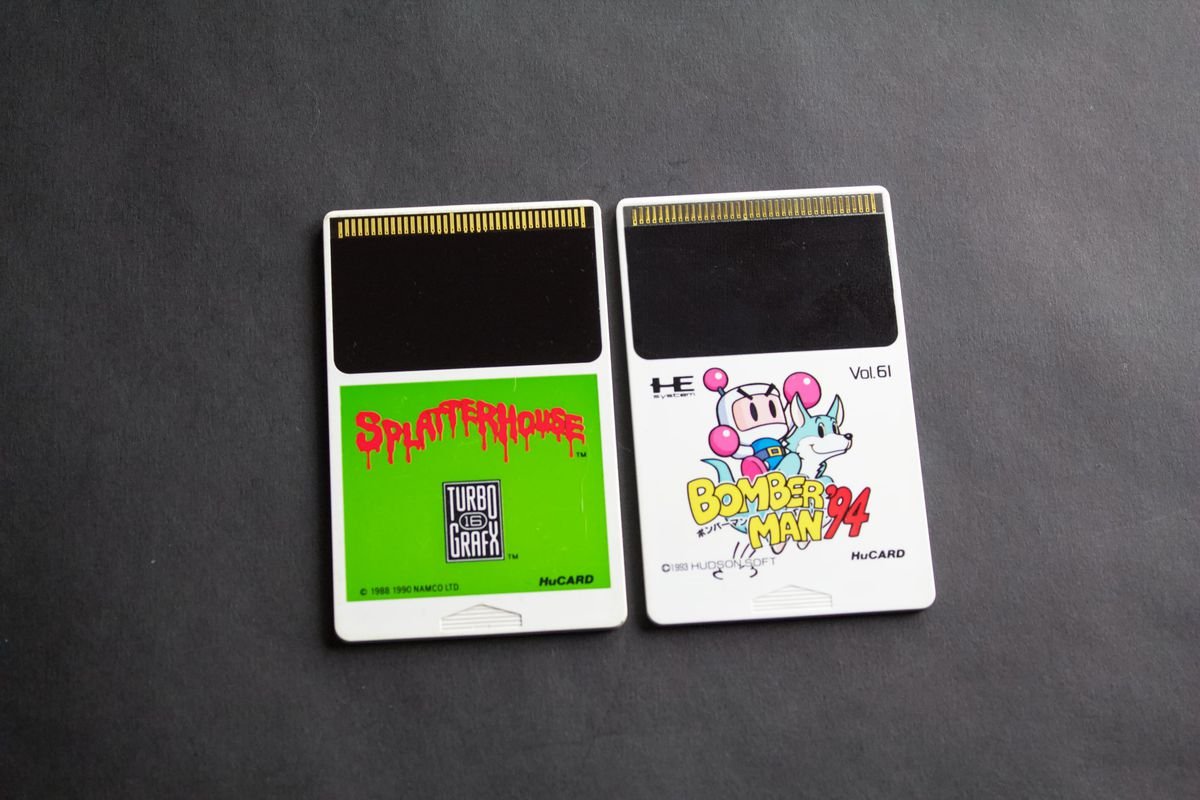The Analogue Duo is the fifth FPGA-based outing for the boutique clone console manufacturer in seven years, an impressive timeline considering that whole global pandemic thing. As such, it represents a meaningful evolution of the company’s approach: This is the first Analogue console with a CD drive as well as a cartridge slot; the first nonportable console to feature the new Analogue OS, which it shares with the Pocket; and the first with a built-in 2.4 GHz receiver for wireless controllers. Another, perhaps less welcome, change is that whereas the previous Analogue consoles emulated video game hall-of-famers like the NES, Sega Genesis, Super Nintendo, and the entire Game Boy pantheon, the Analogue Duo is dedicated to an impressive also-ran, the TurboGrafx-16 (or the PC Engine, as it’s known outside of North America).
So for the TurboGrafx faithful out there (I see you!), let’s dive in.
The hardware
Like every other Analogue console since the Super NT, the Duo is beautiful. I reviewed the black unit, though it also comes in PC Engine white, and when I pre-ordered, this was honestly a difficult choice. The design is more TurboDuo than TurboGrafx (hence the Duo). The TurboDuo was an integrated TurboGrafx unit with the CD drive attachment built in, along with some extra compatibility thanks to BIOS and RAM upgrades.
The Analogue Duo borrows the TurboDuo’s overall shape and squiggly line aesthetic, and even retains the single controller port (one of the TurboGrafx’s strangest design quirks), although it relocates the original front-facing port to the side of the console (one of the Analogue Duo’s strangest design quirks). Also on that left side are a headphone jack and volume knob, just like the TurboDuo, along with four LED lights and a sync button to pair wireless controllers. The rear has your normal array of ports, including two USB ports for controllers and a slot for SD cards to hold screenshots and save states, as well as — presumably — ROM storage if there’s a future jailbreak. (More on that later.) The top-loading CD player has been replaced with a slick, slot-loading drive. The unit feels solid, extremely well built, and full of delightful touches. If you’ve ever held an Analogue device, you know what I mean.
I wasn’t sure I’d like the focus on built-in 2.4 GHz Wi-Fi for controllers, but I have to say, it’s nice not having the dongles sticking out of the ports. And while the purist in me loved knowing I could take those dongles and use them on original hardware, the reality is that I mostly did not do that. As is the company’s usual process, 8BitDo offers a complementary controller to the hardware, and outside of the absence of original port dongles, I found little to complain about. I will note that the Duo team chose to use the same smaller mini-DIN connector here that the PC Engine and TurboDuo consoles used, and not the larger DIN connector that the TurboGrafx-16 inexplicably used. I purchased a DIN-to-mini-DIN adapter and can report that it’s quite functional and quite unattractive. I also snagged a PC Engine controller and multitap, and those similarly work just fine.
Less fine is playing with any original controller, with the surprisingly short 4-foot cords sticking out the side of the console. It’s a good thing, then, that the Analogue Duo also supports Bluetooth controllers! I was able to easily pair my 8BitDo M30, 8BitDo Arcade Stick, and 8BitDo Pro 2 controllers at the same time as the 2.4 GHz Duo controllers.
FPG eh?
While the outside is a beautiful rendition of the TurboDuo, the inside of the Analogue Duo is similarly not a TurboDuo, but instead, a machine headlined by an FPGA chip programmed to act like a TurboDuo. We’ve been over this a bunch — five times with Analogue alone! — but for the folks in the back, FPGA stands for field-programmable gate array, which is a kind of chip that can be configured to act as different types of logic circuits. This makes it ideal for emulating the hardware of classic video game consoles, since it can be programmed to replicate the precise behavior of the original hardware. While Analogue is often eager to market these products as featuring “no emulation,” it’s perhaps easier to think of Analogue’s approach to emulation as distinct from traditional software emulators, and one focused explicitly on accuracy and simplicity, but… it’s still emulation.
So about that emulation! I will say up front that I am not a TurboGrafx-16 expert. I had a handful of HuCards and some burned CDs and, for the purposes of this review, I picked up some more of each. I’m also not enough of an expert to do a frame-by-frame analysis, so I’m not going to come out and say the magic words “cycle accurate.” Instead, I will say that the experience was notably as simple as booting a card or CD, much like with other Analogue systems. And over the dozen-plus hours I spent playing on the Duo, I had zero issues with any of the games I threw at it, including HuCards and CDs from both Japan and the U.S. Considering the complexity of getting all of these things to work on original hardware — just take a peek at this ConsoleMods wiki page — I don’t want to diminish this accomplishment. It’s fair to say it’s the world’s best TurboDuo… for the hundreds out there waiting for just that. (I’m allowed to tease, because I’m one of them.) But that can’t be it, right?

Here’s where we get to the awkward part of every Analogue review: Where’s the jailbreak? For the NT mini, Super NT, and Mega SG, a jailbroken version of the system software would mysteriously appear shortly after the console’s release, enabling a near-identical experience to the stock software with the welcome addition of ROM playback. Since this is a legal gray area at best, the entire internet’s assumption is that Analogue itself is responsible for these jailbreaks and makes them unofficial to avoid any unsavory associations with software piracy. After all, the Analogue consoles work great with original controllers and software, so why complicate things with ROMs when you know the audience for them is already good at Google?
But then came the Analogue Pocket, with its “OpenFPGA” architecture and new Analogue OS interface. Instead of a jailbreak, like we’d become accustomed to, that second, user-facing FPGA enabled developers to create or port other FPGA cores to the Pocket — including ROM-friendly cores for the systems the Pocket was designed to play in the first place, like the Game Boy lineup. No jailbreak needed. Huh.

While the Analogue Duo and the upcoming N64-focused Analogue 3D both share the Analogue OS with the Pocket, they unfortunately do not feature that same OpenFPGA architecture. So it’s anyone’s guess how a jailbreak would work with this console. Will the same screen filter and screenshot/save game functionality work? Will that jailbreak enable other cores à la the Pocket, or will it remain fixed to its namesake system, à la the Super NT and Mega SG cores? Who knows!
If you’re looking for a gorgeous, well-made TurboDuo clone ready to play your prized collection of TurboGrafx-16 HuCards and CDs, then I think you already know this is the product for you. I just honestly don’t think there are enough of those people alive on the planet to make this very fancy piece of hardware a sound business decision. Will there be a jailbreak? That seems inevitable, given that user base (not to mention the wild price of original carts and CDs for this system!).
And that’s where it’s honestly hard to recommend the Duo for all but the most hardcore fans. If you just want a great, well-made machine to run your ROM collection, the Pocket costs $30 less than the Duo and is also an entire, portable-ass handheld with a wild screen. Add the $100 Dock accessory to that, and you’ve got it on your TV as well.
Some of the software still isn’t done, which is something of an Analogue tradition at this point, so I wasn’t able to test the save-state functionality yet. But I also wasn’t able to test the jailbreak, and it’s hard to consider this piece of hardware without that bonus — but vital! — piece of context. I’ll update this review once Analogue releases whatever it’s going to release, but until then, you already know if the Duo is for you.
The Analogue Duo costs $249.99, and initial pre-orders begin shipping on Dec. 11. The Duo was reviewed using hardware and accessories provided by Analogue; other accessories and software was our own. Vox Media has affiliate partnerships. These do not influence editorial content, though Vox Media may earn commissions for products purchased via affiliate links. You can find additional information about Polygon’s ethics policy here.

















































